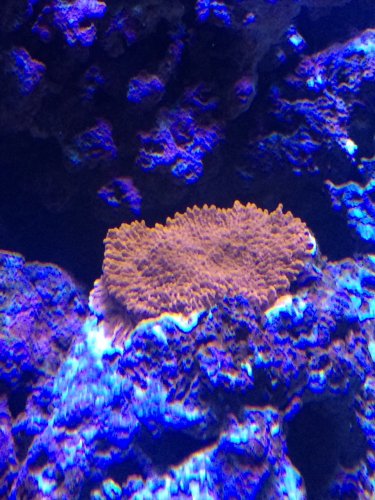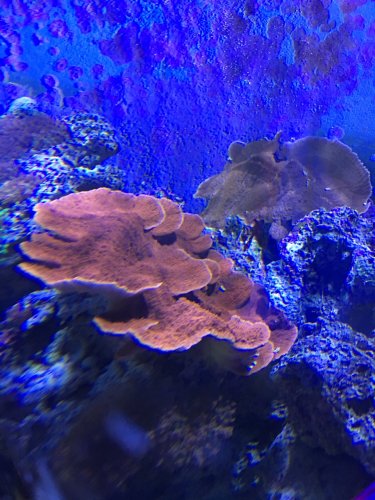Recently I have been researching lighting, in hopes to get a better understanding of how to provide the best source of light for the corals I host in my tank. Currently my tank lighting is provided by a Current Marine Pro HO LED light bar 48" (not the actual size of the bar but the size recommend for my tank by the manufacturer)
I personally am quite happy with the light bar and love its features but have always wondered if it was providing what my coral needed. A few days ago I had the chance of using a ICE CAP 8 bulb t-5 set up I was repairing for a friend, the system contained 2 led bar t-5 style bulbs and 6 t-5 bulbs of different colors (unfortunately I had no way of telling what color or spectrum the bulbs were as I didn't have there original packaging). After making the repairs I decided to try it out over my tank to see what the difference in lighting was, First I should say that this light system was almost the exact size as the dimensions for the top of my tank but had about a 1 1/2 over hang on each side so of the bat the system was made for a bigger and most likely deeper tank but at the time of this little experiment I was more curious about how the lighting would look illuminating my tank.
I was blown away with how bright it was and how well blended the mixture of different color bulbs were it was almost night and day from my LED set up, I sat in awe staring at it and began wondering if my system was powerful enough or if this system was over powered I couldn't know for sure as I wasn't experienced enough with light and its effects on water and a organic eco system.
So after seeing the light "no pun intended" I decided to hang on to the system for a few days and use it to see how my coral would respond to it. My system currently contains mostly soft coral and a few LPS corals that seemed to be doing fine with my LED set up so for me this was new and untested water the first few days I noticed a hand coral I have seemed more open and its polyps seemed to extend farther then I usually saw them and a large toad stool I had that had been shrinking and not looking to well for a long time had expanded and I could see it to had polyps budding the other corals a Dunkin and a few hammers seemed to behaving as they normal did my zoa's how ever seemed to really enjoy the brightness and the mushrooms remained unimpressed
the only coral that didn't seem to like the lighting was my Kenya trees as they kinda remained slightly closed up.
The lighting stayed on my tank for about 4 days before I needed to return it and go back to my LED system but from that point on I have been researching light and how it works and trying to get a better understanding of artificial light vs sunlight and just how well they compare.
I didn't have time to write a full article tonight like I wanted to because there is just way to much to go over but I will return tomorrow to start giving a run down of what I learned so far in hopes that I may help another out there who isn't as familiar with lighting as well
I personally am quite happy with the light bar and love its features but have always wondered if it was providing what my coral needed. A few days ago I had the chance of using a ICE CAP 8 bulb t-5 set up I was repairing for a friend, the system contained 2 led bar t-5 style bulbs and 6 t-5 bulbs of different colors (unfortunately I had no way of telling what color or spectrum the bulbs were as I didn't have there original packaging). After making the repairs I decided to try it out over my tank to see what the difference in lighting was, First I should say that this light system was almost the exact size as the dimensions for the top of my tank but had about a 1 1/2 over hang on each side so of the bat the system was made for a bigger and most likely deeper tank but at the time of this little experiment I was more curious about how the lighting would look illuminating my tank.
I was blown away with how bright it was and how well blended the mixture of different color bulbs were it was almost night and day from my LED set up, I sat in awe staring at it and began wondering if my system was powerful enough or if this system was over powered I couldn't know for sure as I wasn't experienced enough with light and its effects on water and a organic eco system.
So after seeing the light "no pun intended" I decided to hang on to the system for a few days and use it to see how my coral would respond to it. My system currently contains mostly soft coral and a few LPS corals that seemed to be doing fine with my LED set up so for me this was new and untested water the first few days I noticed a hand coral I have seemed more open and its polyps seemed to extend farther then I usually saw them and a large toad stool I had that had been shrinking and not looking to well for a long time had expanded and I could see it to had polyps budding the other corals a Dunkin and a few hammers seemed to behaving as they normal did my zoa's how ever seemed to really enjoy the brightness and the mushrooms remained unimpressed
the only coral that didn't seem to like the lighting was my Kenya trees as they kinda remained slightly closed up.
The lighting stayed on my tank for about 4 days before I needed to return it and go back to my LED system but from that point on I have been researching light and how it works and trying to get a better understanding of artificial light vs sunlight and just how well they compare.
I didn't have time to write a full article tonight like I wanted to because there is just way to much to go over but I will return tomorrow to start giving a run down of what I learned so far in hopes that I may help another out there who isn't as familiar with lighting as well



